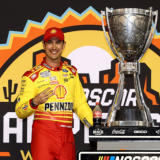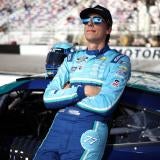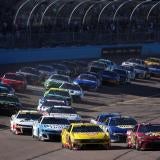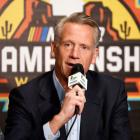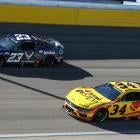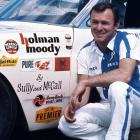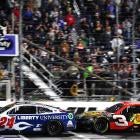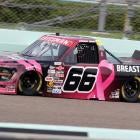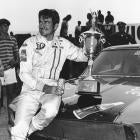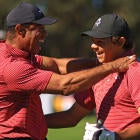
After a long malaise and period of decline led to changes in leadership, the past several years have seen NASCAR go from facing the challenges of its future from a position of weakness to ambitiously pursuing tomorrow from a position of strength. At the forefront of stock car racing's turnaround and re-imagining have been NASCAR president Steve Phelps and chief operating officer Steve O'Donnell, both of whom addressed the media in the annual State of the Sport press conference at Phoenix Raceway on Friday.
While there is still plenty that NASCAR has to improve on and still seeks to accomplish, much has changed since Phelps was promoted to NASCAR president in 2018 to spearhead the sport's renaissance. The Next Gen car, one of the sanctioning body's most ambitious projects, is now finishing its first full season of competition. And that first full season has been an extremely competitive and compelling one, which has helped a changing sport grow again after years of stagnation.
"Thrilled for where this sport is. Thrilled for where the sport is going as we head into our media rights negotiation next year, as we head into kind of unchartered territories," Phelps said . "... We are going to continue to be bold and we're going to continue to be innovative."
Here are some of the notable topics discussed during Phelps and O'Donnell's joint press conference, which was headlined by multiple topics pertaining to competition.
Next Gen Safety
In the full two decades since a safety revolution following the death of Dale Earnhardt, NASCAR's track record on safety had been impeccable and virtually unimpeachable. But the 2022 season brought the dangers of racing back to the forefront, particularly in the second half of the season. The Next Gen car proved to be much too stiff in certain impacts, leading to a spate of concussion issues -- including one suffered by Kurt Busch in a crash at Pocono that ended his season as well as his full-time Cup career.
Competitor anxiety boiled over into outrage by the fall after two different injuries at Texas Motor Speedway, but those have since been assuaged by regular meetings between NASCAR and its competitors on safety and other competition issues. Still, making modifications to the Next Gen car from a safety standpoint is an ongoing process -- with NASCAR seemingly having built a car strong enough to protect the driver in the event of a catastrophic accident (such as Ryan Newman's crash in the 2020 Daytona 500 that saw an intrusion into his cockpit), the focus is now on making drivers take less physical punishment in more minor crashes where issues have been seen this season.
"What we're learning is those smaller hits, which we've never seen before in terms of a car that we've raced, are the ones we really need to concentrate on," O'Donnell said. "That's why you're seeing the tweaks being made to the clip, for those smaller impacts, even a bump on a restart, those types of things.
"It's not just the car. I think the dialogue we've had with the teams now involves how are you fitting in your seat, helmets, foam head surround. All those things are part of this dialogue, which is really, really good. We're seeing some improvements on a daily basis as we look towards 2023."
Next Gen Tweaks and Technology
One of the major points of emphasis in developing the Next Gen car was to create a better racing product on intermediate tracks, and NASCAR has seemingly accomplished that mission. Races on mile-and-a-half and similar tracks have been among the best of the 2022 season, but that's somewhat come at the expense of the racing product on short tracks and road courses, where passing has become more difficult than in the previous generation of Cup car.
While O'Donnell noted that the sample size for such tracks is still relatively small, he did note that aerodynamic and potentially horsepower changes are on the way for those tracks, including some lessons learned from the Garage 56 Le Mans program that could be implemented.
"We have a lot of dialogue going on with the drivers in terms of potentially looking at some power things -- I think that's a little more complicated," O'Donnell said. "There are some things we've looked at even through Garage 56 that we found from an aero standpoint that could be put in place as early as next year for both short tracks and road courses."
Beyond the Next Gen car itself, NASCAR is also moving forward with plans to integrate new automotive technologies, including electrification. O'Donnell hinted that more news on the development of a potential electric car and racing series could come in 2023, with a target of 2024 for on-track implementation.
"The ideal world for NASCAR is you can show up at a racetrack and you can see any form of motorsports you want, any type of power: Electric, hydrogen," O'Donnell said. "You want to see some loud engines going out there, that's NASCAR too. All that is going on behind the scenes."
A large part of such technology would be participation among the sport's OEMs, which currently include Chevrolet, Ford, and Toyota. While NASCAR has been interested in bringing more OEMs into the sport, O'Donnell said that there was no news on that front beyond ongoing dialogue with potential automakers.
The Charter System
While driver contentions about the Next Gen car occupied much of NASCAR's attention during the fall, another brushfire emerged when several team executives went to the media to air their grievances over a lack of progress that has been made in negotiations with the sanctioning body over how much of the revenue split they will receive in NASCAR's next media rights deal. The behind-the-scenes dispute spilling into the public eye was the latest development in an ongoing, long-term process of reforming the sport's business model in order to make race teams less reliant on sponsorship dollars and less liable to operate at a loss.
One major step toward that is the charter model, the franchising model introduced by NASCAR in 2016 to give chartered teams guaranteed entry into each race, two pieces of revenue (fixed revenue and then revenue competed for), and governance in the sport. The current charter agreement is up at the end of 2024, but Phelps indicated that NASCAR would seek to renew the agreement believing it has helped the sport -- even as it has created an entry barrier for prospective new owners.
"I would say the charter system, although not perfect, has worked really well," Phelps said. "You look at the enterprise value, which I'm not going to get into what charters are going for, what they were at, but the number right now is a significant multiple of what it was three years ago. We have people out there that want to get charters who are both in the sport and are outside of the sport that can't get them right now because the teams are holding them. That's their right. Whether we want that to happen or not, there's nothing we can do about that.
"... Do I think we'll extend the charters? I do. Do I think it's a good thing for the sport? I do."
Officiating Obstacles
Officiating a NASCAR race is far from an easy task, as the live-action pace of races dictates that major decisions and judgment calls must be made in real time instead of dissected and reviewed during a stoppage in action. Naturally, this sometimes leads to uneven officiating decisions, some of which have been made this season and then subsequently corrected after the fact -- most notably at Texas in September, when NASCAR officials admitted they missed a call on William Byron intentionally spinning out Denny Hamlin under caution.
O'Donnell somewhat owned up to such mistakes, and he then discussed the role of improved technology in making sure such situations do not happen in the future.
"If we are missing a camera angle, that's on us to fix and make sure we are those things in place," O'Donnell said. "If you take Texas, for instance, one of the angles we should have had in race control, we didn't. Next week we did. We have every single in-car where we were able to see it.
"We'll go back and make sure where do we make mistakes, what technology do we need to really make those decisions in a more timely fashion because we want to make those at the racetrack versus during the week."
Another stir was created this weekend when NASCAR chose not to penalize Xfinity Series driver Austin Hill after he punched fellow driver Myatt Snider on pit road following last Saturday's race at Martinsville Speedway. While O'Donnell said that Hill's actions crossed the line, he said that NASCAR elected not to act given that they had not issued penalties for similar situations earlier in the year.
One of our cameras appears to show Austin Hill punching Myatt Snider after Saturday's Xfinity Series race. #NASCAR pic.twitter.com/ubF1aKM2wd
— NASCAR on NBC (@NASCARonNBC) October 30, 2022
O'Donnell then intimated that potential rule changes on that front in the name of consistency would be in store for next season.
"Our job in the offseason will be to talk to the drivers, get their feedback on where should that line be," O'Donnell said. "Still up to us to make the decision, but I think you'll see some more consistency in terms of what we may do and react to what happened last week with a penalty of some kind for 2023."





